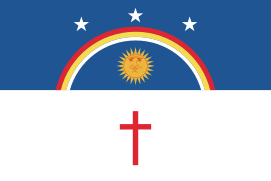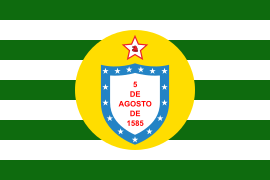User:BaduFerreira/Flag of Paraíba
| This is not a Wikipedia article: It is an individual user's work-in-progress page, and may be incomplete and/or unreliable. For guidance on developing this draft, see Wikipedia:So you made a userspace draft. Find sources: Google (books · news · scholar · free images · WP refs) · FENS · JSTOR · TWL |
 | |
| Use | Civil and state flag |
|---|---|
| Proportion | X:X |
| Adopted | 1 January 1000 |
| Designed by | X |
| Reverse side of the Paraíba flag | |
 | |
| Use | CHANGE |
| Design | CHANGE |
The flag of Paraíba is the official flag of the Brazilian state of Paraíba.
History
[edit]Pernambucan revolt (1817)
[edit]On 1 April 1817, Paraíba adopted a flag based on the "flag of friendship" of the state of Pernambuco as soon as it joined the Pernambucan revolt. This flag was identical to the adopted flag of Pernambuco but without the upper blue stripe. The three stars represented the captaincies of Pernambuco, Paraíba and Rio Grande and other stars would be inserted as other captaincies officially joined the confederation.
-
Flag of the Pernambucan revolt (1817)
-
Flag used by Paraiba during the Pernambucan revolt (1817)
Need a border on the flags here
First official flag (1907–1922)
[edit]The first official flag of Paraíba was adopted on 21 September 1907 by State law nº 266 during the governorship of Valfredo Leal. It was renounced on 7 November 1922 by State Law nº 553 during the governorship of Sólon de Lucena in the wake of a political movement born in the state of Paraná that promoted abandoning state symbols in favor of national ones. The national flag of Brazil was used in Paraiba until the modern day flag was adopted in 1930.
Modern flag (1930)
[edit]The modern flag was adopted on 25 September 1930 by State law nº 704 to honor João Pessoa, the governor of Paraíba and then running mate of Getúlio Vargas. Pessoa was murdered by João Dantas who blamed him for publishing Dantas's initimate correspondences with professor Anaíde Beiriz in the journals of Parahyba do Norte, the capital of Paraíba.
On 29 July 1929, Pessoa joined the governorship of Minas Gerais and Rio Grande do Sul in refusing to support the candidacy of Júlio Prestes
This event further infuriated the upset populace of Paraiba who were unhappy with
The government of the Old Republic of Brazil was largely dominated by wealthy land-owning politicians from the states of Minas Gerais and São Paulo. This form of governance, known as Milk coffee politics due to the respective industries that dominated the two states, saw the presidency largely alternate between the states every election. This changed in 1929 when Brazilian president Washington Luís nominated presidential candidate Júlio Prestes as his successor despite both politicians being from the state of São Paulo. This angered the Minas Gerais elite who formed an alliance with Paraíba and Rio Grande do Sul to support the presidential candidacy of Getúlio Vargas with then governor of Paraíba João Pessoa as his running mate.
created in 1930 and adopted in 1965
Julio prestes wins the election
INCLUDE FLAG WITH É
Symbolism
[edit]References
[edit]- ^ "Bandeira da Paraíba: a história do 'Nego'". Jornal da Paraíba (in Brazilian Portuguese). 2023-04-14. Retrieved 2023-07-25.
- ^ Senado, T. V. (2022-12-27). "O que significa a palavra 'Nego' na bandeira da Paraíba?". TV Senado (in Portuguese). Retrieved 2023-07-25.




